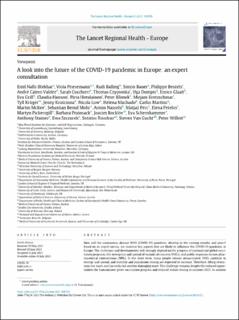| dc.contributor.author | Iftekhar, Emil | |
| dc.contributor.author | Priesemann, Viola | |
| dc.contributor.author | Balling, Rudi | |
| dc.contributor.author | Bauer, Simon | |
| dc.contributor.author | Beutels, Philippe | |
| dc.contributor.author | Calero Valdez, Andre | |
| dc.contributor.author | Cuschieri, Sarah | |
| dc.contributor.author | Czypionka, Thomas | |
| dc.contributor.author | Dumpis, Uga | |
| dc.contributor.author | Glaab, Enrico | |
| dc.contributor.author | Grill, Eva | |
| dc.contributor.author | Hanson, Claudia | |
| dc.contributor.author | Hotulainen, Pirta | |
| dc.contributor.author | Klimek, Peter | |
| dc.contributor.author | Kretzschmar, Mirjam | |
| dc.contributor.author | Krüger, Tyll | |
| dc.contributor.author | Krutzinna, Jenny | |
| dc.contributor.author | Low, Nicola | |
| dc.contributor.author | Machado, Helena | |
| dc.contributor.author | Martins, Carlos | |
| dc.contributor.author | McKee, Martin | |
| dc.contributor.author | Mohr, Sebastian | |
| dc.contributor.author | Nassehi, Armin | |
| dc.contributor.author | Perc, Matjaz | |
| dc.contributor.author | Petelos, Elena | |
| dc.contributor.author | Pickersgill, Martyn | |
| dc.contributor.author | Prainsack, Barbara | |
| dc.contributor.author | Rocklöv, Joacim | |
| dc.contributor.author | Schernhammer, Eva | |
| dc.contributor.author | Staines, Anthony | |
| dc.contributor.author | Szczurek, Ewa | |
| dc.contributor.author | Tsiodras, Sotirios | |
| dc.contributor.author | van gucht, steven | |
| dc.contributor.author | Willeit, Peter | |
| dc.date.accessioned | 2022-03-30T12:21:42Z | |
| dc.date.available | 2022-03-30T12:21:42Z | |
| dc.date.created | 2021-09-08T12:35:11Z | |
| dc.date.issued | 2021 | |
| dc.identifier.issn | 2666-7762 | |
| dc.identifier.uri | https://hdl.handle.net/11250/2988608 | |
| dc.description.abstract | How will the coronavirus disease 2019 (COVID-19) pandemic develop in the coming months and years? Based on an expert survey, we examine key aspects that are likely to influence the COVID-19 pandemic in Europe. The challenges and developments will strongly depend on the progress of national and global vaccination programs, the emergence and spread of variants of concern (VOCs), and public responses to non-pharmaceutical interventions (NPIs). In the short term, many people remain unvaccinated, VOCs continue to emerge and spread, and mobility and population mixing are expected to increase. Therefore, lifting restrictions too much and too early risk another damaging wave. This challenge remains despite the reduced opportunities for transmission given vaccination progress and reduced indoor mixing in summer 2021. In autumn 2021, increased indoor activity might accelerate the spread again, whilst a necessary reintroduction of NPIs might be too slow. The incidence may strongly rise again, possibly filling intensive care units, if vaccination levels are not high enough. A moderate, adaptive level of NPIs will thus remain necessary. These epidemiological aspects combined with economic, social, and health-related consequences provide a more holistic perspective on the future of the COVID-19 pandemic. | en_US |
| dc.language.iso | eng | en_US |
| dc.publisher | Elsevier | en_US |
| dc.relation.uri | https://www.sciencedirect.com/science/article/pii/S2666776221001629?via%3Dihub | |
| dc.rights | Navngivelse 4.0 Internasjonal | * |
| dc.rights.uri | http://creativecommons.org/licenses/by/4.0/deed.no | * |
| dc.title | A look into the future of the COVID-19 pandemic in Europe: an expert consultation | en_US |
| dc.type | Journal article | en_US |
| dc.type | Peer reviewed | en_US |
| dc.description.version | publishedVersion | en_US |
| dc.rights.holder | Copyright 2021 the authors | en_US |
| dc.source.articlenumber | 100185 | en_US |
| cristin.ispublished | true | |
| cristin.fulltext | original | |
| cristin.qualitycode | 1 | |
| dc.identifier.doi | 10.1016/j.lanepe.2021.100185 | |
| dc.identifier.cristin | 1932432 | |
| dc.source.journal | The Lancet Regional Health - Europe | en_US |
| dc.relation.project | EC/H2020/724460 | en_US |
| dc.identifier.citation | The Lancet Regional Health - Europe. 2021, 8, 100185. | en_US |
| dc.source.volume | 8 | en_US |

